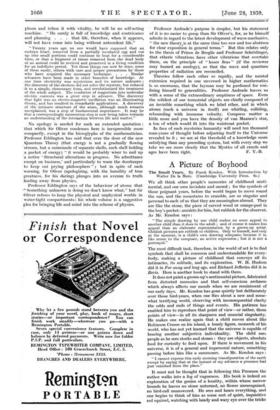A Picture of Boyhood The Small Years. By Frank Kendon.
With Introduction by Walter De la Mare. (Cambridge University Press. 6s.) WE all think other people's memories of childhood senti- mental, and our own inviolate and sacred ; for the symbols of
those poignant years, before the world began to move round the sun, and the mountains to crumble, are so singular and personal to each of us that they are meaningless abroad. They are like the stone, the piece of carved wood or orange-peel in the boy's pocket: amulets for him, but rubbish for the observet. As Mr. Kendon says :
"The simple drawing by one child makes no more appeal to another child than it does to the adult ; and of course it makes less appeal than an elaborate representation by a grown-up artist. Childish pictures are rubbish to children. Only to himself, and only at the moment, is a child's own drawing adequate, because it is, like music to the composer, an active expression ; but it is not a portrayal."
The most difficult task, therefore, in the world of art is to find symbols that shall be common and understandable for every- body, making a picture of childhood that conveys all its intimacies, its solitude, and its exploration. W. H. Hudson did it in Far away and long ago, and Richard Jefferies did it in Bevis. Here is another book to stand with them.
- It does not paint a grown-up's sentimental picture, fabricated from distorted memories and that self-conscious archness which always affects our moods when we are reminiscent of our early days. Mr. Kendon has gone quietly but deliberately over those bird-years, when one flies about a new and some- what terrifying world, observing with inconsequential clarity the odds and ends of things and events. His patience has enabled him to reproduce that point of view—or rather, those points of view—in all its sharpness and unsocial singularity. He makes one realize again that a child moves about like Robinson Crusoe on his island, a lonely figure, monarch of his world, who has not yet learned that the universe is capable of bearing another subjective individuality. The child sees people as he sees stocks and stones : they are objects, absolute food for curiosity to feed upon. If there is movement in his universe, it is of a general and impersonal nature, something passing before him like a summoner. As Mr. Kendon says : -
"I cannot express this early morning transfiguration of the earth except by saying that at the instant of my advance a presence had just vanished from the place."
It must not be thought that in following this Presence the author walks into a fog of vagueness. His book is indeed an
• exploration of the genius of a, locality„ within whose narrow bounds he leaves no. stone unturned, nó flower Unrecognized, no bird-call unanswered. He sees and hears everything, and one begins to think of him as some sort of quiet, inquisitive red squirrel, watching with beady and wary eye over the tricks and whimsies which Nature is too shy to display before the intellectual gaze of man. Here is an example of such intimate observation :—
" I passed a steep bank by the ale-house garden. It was deep with rank grass, nettles, goose grass, hedge-garlick and new vetches ; in the angle between leaves and stems heavy dew lay in drops, but a path worn by-the 'feet of village children led barely through these grasses to a natural doorway, and this led into a wood where I had never ventured. I climbed the bank and looked in. As yet the level sun had not shone in, and the place was a dark cavern with its roof supported by thousands of slender pillars, and in that darkness nothing could grow but wild parsley, fools' parsley, which comes from nothing to a flower in a week, so suddenly that its flat discs of white flowers are a yearly surprise. It grew deep and shadowy, away from this natural gate into the fastnesses of the wood, all its umbels standing at a level, a thin surface of parsley flowers whose stems were so numerous and so shaded that they stood to support them unseen, and the flower heads seemed to be floating in the still, dark air, a foot above the ground."
A page does not pass without some such quotable passage. The writing is simple and direct, but so sensitive and acute is the impulse behind it that the reader finds himself pausing again and again, cajoled into recollection of his own childhood, and forced by the magic of Mr. Kendon's inspired sincerity to wander back along many paths that time, misery, and too- much-with-the-worldliness had long since closed. Therefore, the book, like all books which make one feel sharply, cannot be read lightly, or reviewed in a casual, professional way.
These Kentish scenes, these local people, all of them characters as vivid as old Peggotty, are not a bookman's stuff : they are the living world of a man who shares in them unself-con- sciously, and who has no thought of copy-hunting. It might be a boy speaking about his catapult, his cricket-bat, or his big brother ; but a boy who has been gifted with that rare thing, the craft of writing, and who can thus express, without fuss or affectation, "the countenance of quietness." That is a beautiful phrase, and in quoting it one touches perhaps the secret of Mr. Kendon's personality. I should not be surprised if Goudhurst and its neighbourhood, where his childhood was
spent, becomes another Selborne. RICHARD CHURCH.



















































 Previous page
Previous page